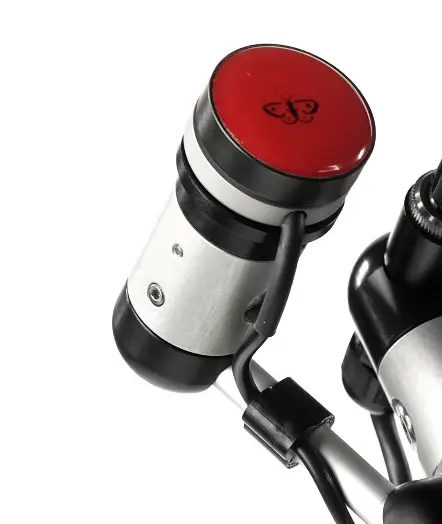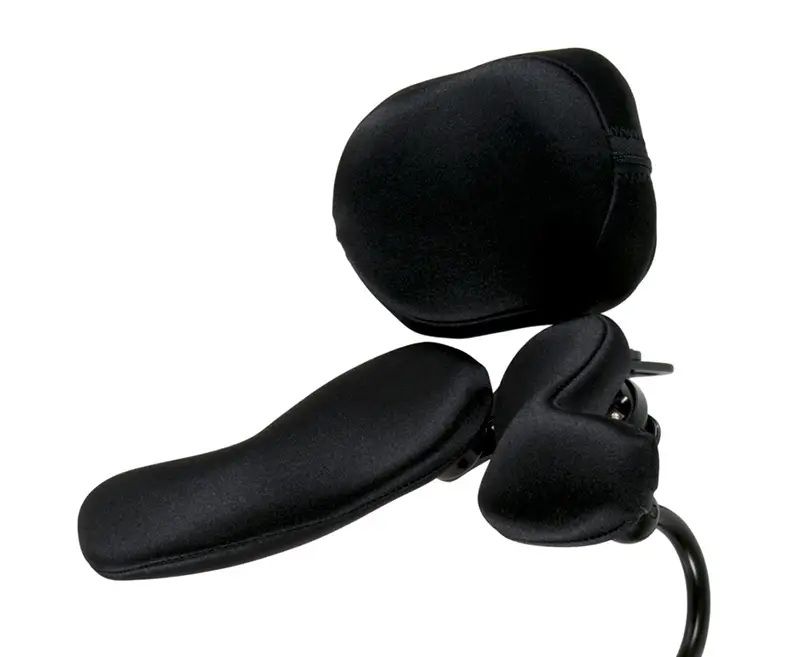Looking for more information about the Switch-It Vigo head control? We've compiled the answers to several frequently asked questions here.
Can alternative switches be used with the Vigo?
 Buddy button switch mounted on armrest using Link-It hardware
Buddy button switch mounted on armrest using Link-It hardware
Yes! Some individuals may have greater ease of access with a more traditional style switch of powering on/off, as well as another for controlling modes. Any external switch that can be plugged into a 3.5mm jack is compatible with the system, such as Switch-It buttons and switches.
How do you move the wheelchair using the Vigo?
The wheelchair moves in response to head movements, read by gyroscope and communicated via Bluetooth. Intuitive forward or rearward tilt (flexion and extension) movement moves the wheelchair forward and backward. Lateral movement of the head (moving the ear toward the shoulder) will steer the wheelchair left or right. Head rotation does not activate the wheelchair movement, which allows the driver to look left and right safely.
The sensors note how the head is tilted. Turning the system on calibrates it to the current head position. The bigger the movement, the faster the wheelchair will drive. Tapping the switch in the headrest (or other location) will stop the wheelchair. The chair will stop with sudden movements.
Can the system be programmed for unique rider needs?
Yes, system parameters can be programmed for optimal wheelchair control, such as speed, acceleration, torque, and deceleration using standard R-Net programming options. Additionally, the Vigo has an application to customize head movement range to tailor operation to the driver's comfortable range of movements via downloadable Vigo software and the system's USB dongle.
Programming also allows for setting a deadzone, which works much like a deadzone on a standard joystick controller. The deadzone is the range within which the system will ignore head movements. This allows small head movements to be ignored for smooth driving when travelling over rougher terrain like pavements, carpets, or thresholds.
What are the safety parameters of the Vigo head control?
There is an emergency brake which can be programmed for sensitivity. The chair will automatically stop when the backward tilt happens too fast. The sensor picks up on the lack of control and stops the chair. A separate stop switch or button can also be attached through the Cubo receiver. The Vigo programming enables setting of maximum head tilting rearward, forward, and laterally. If a driver goes beyond this, the system stops, such as when the head drops forward when nodding off.
How is my phone or computer attached to the Vigo head control?
The Vigo headset pairs with a smartphone, computer, or other device through Bluetooth and the R-NET control system. This works in a similar way to controlling a Bluetooth device with the OMNI 2 or R-NET with other special input devices. The key difference with Vigo is that it can also control a computer or smartphone directly using a USB dongle plugged directly into the computer, or into the smartphone via a USB adapter. Control via a dongle does not require any additional direct programming through the power wheelchair's control system.
How is the Vigo charged?
The Vigo is charged through a standard mini USB cable. The batter life depends on the use of the system. It has a battery life of about 14 hours when used for driving and mouse control only. As it has a second chip that allows it to function just like any Bluetooth headset, using this secondary chip will reduce battery life. For example, it is possible to drive a power wheelchair with the Vigo while listening to music through the headset. This causes a greater drain on the the device's battery. If both chips are in constant use, the battery life would be halved, to around seven hours.
Switch-It recommends charging via a magnetic end cable. This allows the mini USB plug to remain in the Vigo, with the rest of the charging cable attaching magnetically. This protects the charge port from accidental damage from inserting the charger too hard or being pulled while charging.
When there are approximately 10 minutes of charge left, the Vigo will announce "battery low." Even though most people will have plenty of battery life for all-day use, it is recommended to bring along a power bank when going outdoors away from a power source.
Additional considerations
A head support that allows regular resting to prevent fatigue is recommended. Consider a style that has lateral cervical pads (such as the Whitmyer S.O.F.T. series) for comfort, even when using for long durations.
 Whitmyer S.O.F.T. Dual Sub-Occipital Head Support
Whitmyer S.O.F.T. Dual Sub-Occipital Head Support
The Vigo represents an option for drivers who need a head control that does not obstruct vision, adapts to shifting posture over the day, or just has a low profile. Find out more about the right kind of individual for this head control so you and your client can make the best choice and get out there.
The Vigo and Cubo contain components and radios that emit electromagnetic radiation. While it is rare, electromagnetic waves may interfere with pacemakers, defibrillators, or other medical devices. If you have any concerns, consulting with your physician about use of a Vigo is highly recommended.
Faith Brown is an HCPC-registered occupational therapist with over 20 years of international experience in the field of seating and mobility including the British National Health Service, as well as the private and NGO sectors. She has worked with all ages and levels of complexity, including leading an NHS special seating division. She is a research champion for the Royal College of Occupational Therapists and has a history of lifelong professional development. Her post-qualification education includes a postgraduate certificate in Postural Management for People with Complex Disabilities from Oxford Brookes University, an MSc in Health Research Methods from the University of Birmingham (UK) and completion of an engineering module in wheelchair design at the University of San Francisco.
With over 40 years of clinical practice as an OT, Jessica Pedersen has worked in all sectors of the wheelchair and seating industry as a master clinician, supplier, manufacturing consultant, design representative, and educator. Dr. Pedersen was a pioneer in the development of the profession of wheelchairs and seating in the 1980s and has spent the last two decades contributing to the research world to demonstrate evidence for knowledge translation in the clinic, advocacy, and product development. She is a RESNA and AOTA Fellow, serves on the Clinician Task Force, the Seating and Wheeled Mobility Committee for AOTA, and has shared her experiences internationally through publications and presentations.